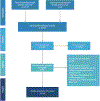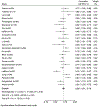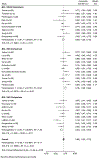Systematic review and meta-analysis of the correlation between bispectral index (BIS) and clinical sedation scales: Toward defining the role of BIS in critically ill patients
- PMID: 35707961
- PMCID: PMC9671609
- DOI: 10.1002/phar.2712
Systematic review and meta-analysis of the correlation between bispectral index (BIS) and clinical sedation scales: Toward defining the role of BIS in critically ill patients
Abstract
Introduction: The bispectral index (BIS) is an attractive approach for monitoring level of consciousness in critically ill patients, particularly during paralysis, when commonly used sedation scales cannot be used.
Objectives: As a first step toward establishing the utility of BIS during paralysis, this review examines the strength of correlation between BIS and clinical sedation scales in a broad population of non-paralyzed, critically ill adults.
Methods: We included studies evaluating the strength of correlation between concurrent assessments of BIS and Richmond Agitation Sedation Scale (RASS), Ramsay Sedation Scale (RSS), or Sedation Agitation Scale (SAS) in critically ill adult patients. Studies involving assessment of depth sedation periperative or procedural time periods, and those reporting BIS and sedation scale assessments conducted >5 min apart or while neuromuscular blocking agents (NMBA) were administered, were excluded. Data were abstracted on sedation scale, correlation coefficients, setting, patient characteristics, and BIS assessment characteristics that could impact the quality of the studies.
Results: Twenty-four studies which enrolled 1235 patients met inclusion criteria. The correlation between BIS and RASS, RSS, and SAS overall was 0.68 (95% confidence interval, 0.61-0.74, Ƭ2 = 0.06 I2 = 71.26%). Subgroup analysis by sedation scale indicated that the correlation between BIS and RASS, RSS, and SAS were 0.66 (95% confidence interval 0.58-0.73, Ƭ2 = 0.01 I2 = 30.20%), 0.76 (95% confidence interval 0.69-0.82, Ƭ2 = 0.04 I2 = 67.15%), and 0.53 (95% confidence interval 0.42-0.63, Ƭ2 = 0.01 I2 = 26.59%), respectively. Factors associated with significant heterogeneity included comparator clinical sedation scale, neurologic injury, and the type of intensive care unit (ICU) population.
Conclusions: BIS demonstrated moderate to strong correlation with clinical sedation scales in adult ICU patients, providing preliminary evidence for the validity of BIS as a measure of sedation intensity when clinical scales cannot be used. Future studies should determine whether BIS monitoring is safe and effective in improving outcomes in patients receiving NMBA treatment.
Keywords: Ramsay Sedation Scale; Richmond Agitation Sedation Scale; Sedation Agitation Scale; bispectral index; intensive care unit.
© 2022 Pharmacotherapy Publications, Inc.
Conflict of interest statement
Figures





References
-
- Coppock Kristen. Hospitals Reporting Short Supplies of Neuromuscular Blockers. Pharm Times. Published online May 8, 2020. Accessed March 14, 2022. https://www.pharmacytimes.com/view/short-supply-of-neuromuscular-blocker...
Publication types
MeSH terms
Substances
Grants and funding
LinkOut - more resources
Full Text Sources
Research Materials
Miscellaneous

